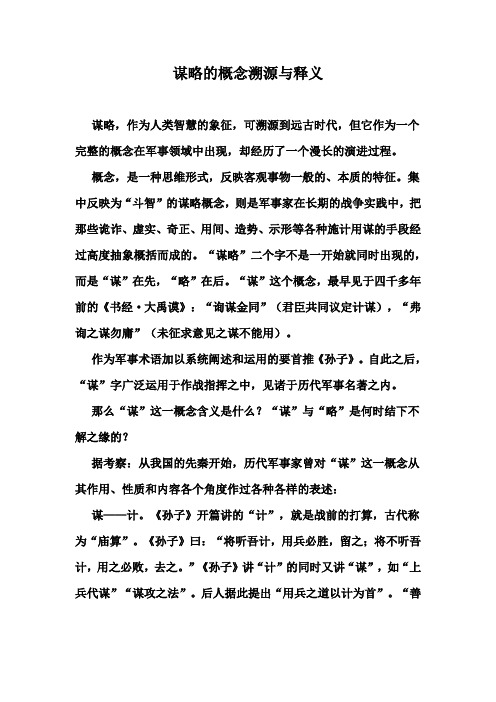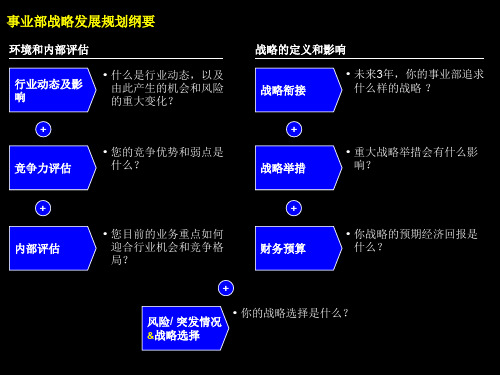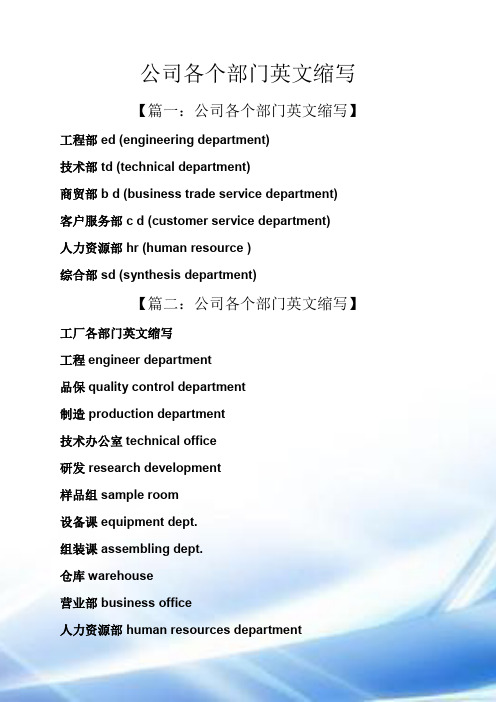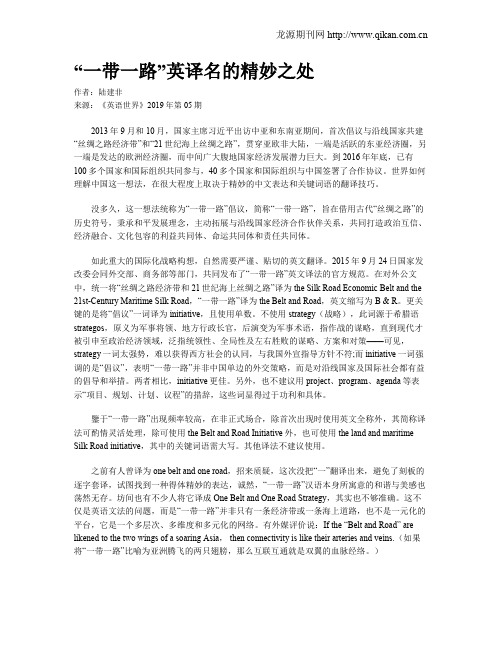战略(英文)
管理学中英文单词对照

第一章管理总论Manager 管理者First-line managers 基层管理者Middle managers 中层管理者Top managers 高层管理者Management 管理Efficiency 效率Effectiveness 效果Planning 计划Organizing 组织Leading 领导Controlling 控制Management process 管理过程Management roles 管理角色Interpersonal roles 人际关系角色Informational roles 信息传递角色Decisional roles 决策制定角色Technical skills 技术技能Human skills 人事技能Conceptual skills 概念技能System 系统Closed systems 封闭系统Open systems 开放系统Environment 环境Special environment 具体环境General environment 一般环境Contingency perspective 权变观Organization 组织Universality of management 管理的普遍性Nonmanagerial employees / Operatives 操作者第二章管理的历史Division of labor 劳动分工Industrial revolution 产业革命Scientific management 科学管理Therbligs 基本动作元素General administrative theorists 一般行政管理理论家Principles of management 管理原则Bureaucracy 官僚行政组织、层级组织Quantitative approach 定量方法Organizational behavior (OB) 组织行为Hawthorne Studies 霍桑研究Workforce diversity 员工多样化Entrepreneurship 企业家e-business (electronic business) 电子商务e-commerce (electronic commerce) 电子贸易、电子商务Intranet 内部互联网Total quality management (TQM) 全面质量管理Learning organization 学习型组织Knowledge management 知识管理Workplace spirituality 团队精神第三章计划Decision 决策Decision-making process 决策过程Problem 问题Decision criteria 决策标准Implementation 实施Rational decision making 理性决策Bounded rationality 有限理性Satisficing 满意Escalation of commitment 承诺升级Intuitive decision making 直觉决策Well-structured problems 结构良好问题Programmed decision 程序化决策Procedure 程序Rule 规则Policy 政策Poorly structured problems 结构不良问题Nonprogrammed decisions 非程序化决策Certainty 确定性Risk 风险性Uncertainty 不确定性Directive style 指导性风格Analytic style 分析性风格Conceptual style 概念性风格Behavioral style 行为性风格Planning 计划Goals 目标Plans 计划Strategic plans 战略计划Operational plans 作业计划Long-term plans 长期计划Short-term plans 短期计划Specific plans 具体性计划Directional plans 指导性计划Single-use plan 单一目标计划Standing plans 标准计划Traditional goal setting 传统目标设定Means-ends chain 手段-结果链Management by objectives (MBO) 目标管理Mission 使命Commitment concept 承诺概念Formal planning department 正式计划部门Strategic management 战略管理Strategic management process 战略管理过程Opportunities 机会Threats 威胁Core competencies 核心能力Strengths 优势Weaknesses 劣势SWOT analysis SWOT分析Corporate-level strategy 公司层战略Stability strategy 稳定战略Growth strategy 增长战略Related diversification 相关领域多元化经营Unrelated diversification 不相关领域多元化经营Retrenchment strategy 收缩战略BCG matrix BCG矩阵波士顿咨询集团矩阵Business-level strategy 事业层战略Strategic business units 战略经营单位Competitive advantage 竞争优势Cost leadership strategy 成本领先战略Differentiation strategy 差异化战略Focus strategy 集中化战略Functional-level strategy 职能层战略Environmental Scanning 环境扫描Competitor intelligence 竞争者情报、竞争者信息Forecasts 预测Quantitative forecasting 定量预测Qualitative forecasting 定性预测Forecasting Techniques 预测技术Benchmarking 基准化、标杆Resources 资源Budget 预算Revenue Budgets 收入预算Expense Budgets 费用预算Profit Budgets 利润预算Cash Budgets 现金预算Scheduling 进度计划、规划Gantt Charts 甘特图Load Charts 负荷图PERT network 计划评审技术网络Events 事件Activities 活动Slack time 松弛时间Critical path 关键线路Breakeven analysis 盈亏平衡分析Linear programming 线性规划Project 项目Project Management 项目管理Scenario 设想方案第四章组织Organizing 组织Organizational structure 组织结构Organizational design 组织设计Work specialization 劳动分工Departmentalization 部门化Functional departmentalization 职能部门化Product departmentalization 产品部门化Geographical departmentalization 地区部门化Process departmentalization 过程部门化Customer departmentalization 顾客部门化Cross-functional teams 跨职能团队Chain of command 指挥链Authority 职权Responsibility 职责Unity of command 统一指挥Span of control 管理幅度Centralization 集权化Decentralization 分权化Formalization 正规化Mechanistic organization 机械式组织Organic organization 有机式组织Unit production 单件生产Mass production 大量生产Process production 连续生产Simple structure 简单结构Functional structure 职能型结构Divisional structure 分部型结构Team-based structure 团队结构Matrix structure 矩阵结构Project structure 项目结构Autonomous internal units 内部自治单位Boundaryless organization 无边界组织Learning organization 学习型组织High-performance work practice 高绩效的工作实践Human resource management process 人力资源管理过程Labor union 工会Human resource planning 人力资源规划Job analysis 职务分析Job description 职务说明书Job specification 职务规范Recruitment 招聘Decruitment 解聘Selection process 甄选过程Validity 效度Reliability 信度Work sampling 工作抽样Assessment centers 测评中心Orientation 定向、导向Performance management system 绩效管理系统Written essay 书面描述法Critical incidents 关键事件法Graphic rating scales 评分表法Behaviorally anchored rating scales (BARS) 行为定位评分法Multiperson comparisons 多人比较法Group order ranking 分组排序法Individual ranking 个体排序法Paired comparison 配对比较法360 degree feedback 360度反馈skill-based pay 按技能付酬Career 职业生涯、职业Organizational change 组织变革Change agents 变革推动者Organizational development (OD) 组织发展Stress 压力Creativity 创造Innovation 创新第五章领导Behavior 行为Organizational behavior 组织行为学Attitudes 态度Cognitive component 认知成分Affective component 情感成分Behavioral component 行为成分Job satisfaction 工作满意度Job involvement 工作投入Organizational commitment 组织承诺Organizational citizenship behavior (OCB) 组织公民行为Cognitive dissonance 认知失调Attitude surveys 态度调查Personality 人性Big-five model 重要的五大模型Emotional intelligence (EI) 情感智商Locus of control 控制点Machiavellianism 马基雅维里主义Self-esteem 自尊Self-monitoring 自我监控Perception 知觉Attribution theory 归因理论Fundamental attribution error 基本归因错误Self-serving bias 自我服务偏见Selectivity 有选择地接受、选择性Assumed similarity 假设相似性Stereotyping 刻板印象Learning 学习Operant conditioning 操作性条件反射Social learning theory 社会学习理论Shaping behavior 行为塑造Motivation 动机Need 需要Hierarchy of needs theory 需要层次理论Physiological needs 生理需要Safety needs 安全需要Social needs 社会需要Esteem needs 尊重需要Self-actualization needs 自我实现需要Theory X X理论Theory Y Y理论Motivation-hygiene theory 激励-保健理论Hygiene factors 保健因素Motivators 激励因素Three-needs theory 三种需要理论Need for achievement (nAch) 成就需要Need for power (nPow) 权力需要Need for affiliation (nAff) 归属需要Goal-setting theory 目标设定理论Reinforcement theory 强化理论Reinforcers 强化物Job design 职务设计Job scope 职务范围Job enlargement 职务扩大化Job enrichment 工作丰富化Job depth 职务深度Job characteristic model (JCM) 职务特征模型Skill variety 技能多样性Task identity 任务同一性Task significance 任务重要性Autonomy 自主性Feedback 反馈Equity theory 公平理论Referents 参照对象Expectancy theory 期望理论Compressed workweek 压缩工作周Flexible work hours 弹性工作制Job sharing 职务分担Contingent workers 应急工Telecommuting 电子通信,远程办公Pay-for performance programs 基于绩效的薪酬管理Open-book management 公开帐簿管理Leader 领导者Leadership 领导Behavioral theories 行为理论Autocratic style 权威式Democratic style 民主式Laissez-faire style 放任式Initiating structure 定规维度Consideration 关怀维度High-high leader 高-高型领导者Managerial grid 管理方格论Fiedler contingency model 菲德勒权变模型Least-preferred co-worker (LPC) questionnaire 最难共事者问卷Leader-member relations 领导者-成员关系,上下级关系Task structure 任务结构Position power 职位权力Situational leadership theory (SLT) 情景领导理论Readiness 准备状态Maturity 成熟度Leader participation model 领导者参与模型Path-goal theory 路径-目标理论Transactional leaders 事务型领导者Transformational leaders 变革型领导者Charismatic leader 超凡魅力的领导者Visionary leadership 愿景领导者Legitimate power 法定权Coercive power 强制权Reward power 奖赏权Expert power 专长权Referent power 模范权Credibility 可信度Trust 诚信、信任Empowerment 授权Communication 沟通Interpersonal communication 人际沟通Organizational communication 组织沟通Message 信息Encoding 编码Channel 通道、渠道Decoding 解码Communication process 沟通过程Noise 噪音Nonverbal communication 非言语沟通Body language 体态语言Verbal intonation 语调Filtering 过滤Selective perception 选择性知觉Information overload 信息超载Jargon 行话Active listening 积极倾听Formal communication 正式沟通Informal communication 非正式沟通Downward communication 下行沟通、向下交流Upward communication 上行沟通、向上交流Lateral communication 平行沟通、横向交流Diagonal communication 斜行沟通、越级交流Communication networks 沟通网络Grapevine 小道信息、谣言E-mail 电子邮件Instant messaging (IM) 即时信息Voice mail 声音邮件Fax 传真Electronic data interchange (EDI) 电子数据交换Teleconferencing 电信会议Videoconferencing 视频会议Intranet 内部互联网Extranet 外部互联网第六章控制Control 控制Market control 市场控制Bureaucratic control 官僚组织控制、层级控制Control process 控制过程Management by walking around (MBWA) 走动式管理Range of variation 偏差范围Immediate corrective action 立即纠正行动Basic corrective action 彻底纠正行动Feedforward control 前馈控制Concurrent control 同期控制、现场控制Feedback control 反馈控制。
谋略的概念溯源与释义

谋略的概念溯源与释义谋略,作为人类智慧的象征,可溯源到远古时代,但它作为一个完整的概念在军事领域中出现,却经历了一个漫长的演进过程。
概念,是一种思维形式,反映客观事物一般的、本质的特征。
集中反映为“斗智”的谋略概念,则是军事家在长期的战争实践中,把那些诡诈、虚实、奇正、用间、造势、示形等各种施计用谋的手段经过高度抽象概括而成的。
“谋略”二个字不是一开始就同时出现的,而是“谋”在先,“略”在后。
“谋”这个概念,最早见于四千多年前的《书经·大禹谟》:“询谋金同”(君臣共同议定计谋),“弗询之谋勿庸”(未征求意见之谋不能用)。
作为军事术语加以系统阐述和运用的要首推《孙子》。
自此之后,“谋”字广泛运用于作战指挥之中,见诸于历代军事名著之内。
那么“谋”这一概念含义是什么?“谋”与“略”是何时结下不解之缘的?据考察:从我国的先秦开始,历代军事家曾对“谋”这一概念从其作用、性质和内容各个角度作过各种各样的表述:谋——计。
《孙子》开篇讲的“计”,就是战前的打算,古代称为“庙算”。
《孙子》曰:“将听吾计,用兵必胜,留之;将不听吾计,用之必败,去之。
”《孙子》讲“计”的同时又讲“谋”,如“上兵代谋”“谋攻之法”。
后人据此提出“用兵之道以计为首”。
“善计者,因敌而生。
”“深计远虑,所以不穷”。
“先作万全之计,然后图彼”可见计和谋是相联系的。
谋——智。
《孙子·计篇》论将:“将者,智、信、仁、勇、严也。
”对将帅品质的五字要求,以“智”为首。
《司马法》中讲到:“凡战,智也。
”这里的智就是讲的智谋。
谋与智密不可分,战离不开智,智者谋也,足智方能多谋。
《六韬·六守第六》中说:“事之而不穷者谋也”。
就是说日理万机,应变不穷,非常机智,这就是谋的表现。
《吴子》明确提出:“智者为谋主”。
无智者是不能做当时的“参谋官”的。
谋——权。
《孙子》说过:“悬权而动”是指把敌我情况比较衡量后再采取行动。
所谓“权”就是“称”(称锤),权衡利弊的意思。
战略(英文翻译)ppt课件

IIIA.战略衔接 - 概要
A. 未来3年,你的事业部将推行什么样的战略?
A.1 竞争在哪里? A.2 你的客户对你服务的
不同环节的价值主张 是什么? A.3 你的商业模式是什么 ? A.4 您的战略选择如何利 用产业机遇与行业/竞 争威胁?
指引: 这一中心问题的答案需要
该部分的主要研究 结果概括
IIC.内部评估 - 备份 2
C.2 延续主要事业部KPI 有 什么效果?
• 过去的3-5年的KPI绩效的趋势,如回报率(ROCE)资本,营业收
入,利润,资本雇用
• 评估的潜在趋势驱动 • 预期演变
资本收益率 =营业收入 x (1-税率 ) 所有附息债务(短期和长期) + 少数股东权 益+股东权益
• Possible strategic initiatives list
22
IIIB. STRATEGIC INITIATIVES – BACK-UP 2
B.2 What are the sources of value created from each strategic initiative?
A.1 你竞争的行业是什么? 该行业主要 的细分市场有哪些?
A.2 产业结构如何变化(需求,供 应和产业链的经济学)?是什 么造成机遇和风险?
A.3预期竞争对手的行为是什么? 是什么造成的机遇和风险?
A.4 当前和未来的外部因素可能带 来新的机遇和风险是什么?
指引 : 这一总体问题的答案
需要本节的主要 结论概括
B2. What are the sources of value created from each strategic initiative?
B3. How much value will be created from each strategic initiative?
strategy英文的名词解释

strategy英文的名词解释英文中的strategy(战略)一词源于希腊语中的strategos,意为将领。
在现代用法中,strategy被广泛应用于各个领域,包括商业、军事、政治和个人生活等。
无论在哪个领域,strategy都是指一种有针对性、经过深思熟虑的计划或方法,旨在达到某个特定的目标。
战略在商业领域中是一门重要的学科。
一个企业的战略是指它为实现长期发展目标而制定的计划。
战略的制定需要全面考虑内外部环境因素,明确公司的使命和愿景,并制定相应的目标和策略。
战略的制定也需要充分了解竞争对手的优势和弱点,并找到差异化的竞争策略来获得市场份额。
与商业战略相似,军事战略是指军队为实现战争目标而采取的全面计划。
在军事领域中,战略涉及到部队的指挥、布阵、装备选择以及军事行动的安排。
军事战略的制定也需要考虑各种因素,如地形、敌人的强弱、物资供给等等。
一个成功的军事战略在保证战胜敌人的同时,也需要尽量减少自己的伤亡和资源消耗。
政治战略则是政治家和政党为赢得选举或实现特定政治目标而采取的手段和策略。
政治战略通常涉及如何吸引选民、传递信息、建立联盟等等。
政治战略的成功与否往往取决于政治家的智慧和沟通能力。
除了在商业、军事和政治领域,战略也在个人生活中起着重要的作用。
个人战略是指个人为实现特定目标而采取的计划和方法。
一个成功的个人战略需要做到目标明确、行动有序、思考周全。
在职业生涯中,人们需要制定职业发展战略,包括规划学习、工作经验积累以及人际关系建立等。
在个人生活中,人们也需要制定健康、财务和家庭等方面的战略,以实现平衡和富足。
总之,strategy是一种有目标、有计划、有方法的行动方式,应用广泛。
无论是企业、军队、政治家还是个人,都需要制定并执行战略,以期实现自己的目标。
战略的制定需要全面考虑内外部因素,深思熟虑,具备创新思维并充分了解竞争环境。
在变幻莫测的世界中,好的战略能够帮助我们应对挑战,实现成功。
公司各个部门英文缩写

公司各个部门英文缩写【篇一:公司各个部门英文缩写】工程部 ed (engineering department)技术部 td (technical department)商贸部 b d (business trade service department)客户服务部 c d (customer service department)人力资源部 hr (human resource )综合部 sd (synthesis department)【篇二:公司各个部门英文缩写】工厂各部门英文缩写工程engineer department品保quality control department制造 production department技术办公室technical office研发 research development样品组 sample room设备课 equipment dept.组装课 assembling dept.仓库warehouse营业部 business office人力资源部 human resources department总务部 general affairs department财务部 general accounting department销售部 sales department促销部 sales promotion department国际部 international department出口部 export department进口部 import department公共关系 public relations department广告部 advertising department企划部 planning department产品开发部 product development department研发部 research and development department(r d)秘书室 secretarial pool采购部 purchasing department工程部 engineering department行政部 admin. department人力资源部 hr departmentmarketing department技术部 technolog department客服部 service department行政部 administration财务部 financial department董事长室 the chairmans roomdirecotor, or president副 deputy director, or vice presidentgeneral deparment采购部 purchase order department工程部 engineering deparment研发部 research deparment生产部 productive department销售部 sales deparment业务部 branch deparment事业部 department拓展部 business expending department物供部 supply departmentb&d business and development 业务拓展部marketingsales 销售部hr 人力资源部account 会计部pr people relationship 公共关系部ofc (office, 但不常见) / omb = office of management and budget 办公室finance 财务部mktg (marketing)r d (research development) 研发部mfg (manufacturing) 产品部administration dept. 管理部purchasing dept 采购部chairman/president office // gerneral manager office or gm office 总经理办公室monitor support department 监事会strategy research 战略研究部外销部:overseas department,international sales section,export section财务科:financial/fiscal department会议室:meeting room/hall/auditorium,或conferencehall/auditorium或直接auditorium, 视其大小而定了。
“一带一路”英译名的精妙之处

“一带一路”英译名的精妙之处作者:陆建非来源:《英语世界》2019年第05期2013年9月和10月,国家主席习近平出访中亚和东南亚期间,首次倡议与沿线国家共建“丝绸之路经济带”和“21世纪海上丝绸之路”,贯穿亚欧非大陆,一端是活跃的东亚经济圈,另一端是发达的欧洲经济圈,而中间广大腹地国家经济发展潜力巨大。
到2016年年底,已有100多个国家和国际组织共同参与,40多个国家和国际组织与中国签署了合作协议。
世界如何理解中国这一想法,在很大程度上取决于精妙的中文表达和关键词语的翻译技巧。
没多久,这一想法统称为“一带一路”倡议,简称“一带一路”,旨在借用古代“丝绸之路”的历史符号,秉承和平发展理念,主动拓展与沿线国家经济合作伙伴关系,共同打造政治互信、经济融合、文化包容的利益共同体、命运共同体和责任共同体。
如此重大的国际化战略构想,自然需要严谨、贴切的英文翻译。
2015年9月24日国家发改委会同外交部、商务部等部门,共同发布了“一带一路”英文译法的官方规范。
在对外公文中,统一将“丝绸之路经济带和21世纪海上丝绸之路”译为the Silk Road Economic Belt and the 21st-Century Maritime Silk Road,“一带一路”译为the Belt and Road,英文缩写为B & R。
更关键的是将“倡议”一词译为initiative,且使用单数。
不使用strategy(战略),此词源于希腊语strategos,原义为军事将领、地方行政长官,后演变为军事术语,指作战的谋略,直到现代才被引申至政治经济领域,泛指统领性、全局性及左右胜败的谋略、方案和对策——可见,strategy一词太强势,难以获得西方社会的认同,与我国外宣指导方针不符;而initiative一词强调的是“倡议”,表明“一带一路”并非中国单边的外交策略,而是对沿线国家及国际社会都有益的倡导和举措。
极限飞盘中英文术语

极限飞盘中英文术语Act of Throwi ng 扔盘动作。
手臂向前运盘但还没出手时的动作。
Aggro Aggressive 的缩写。
指的是个人或队伍比赛精神较差、过于好斗的表现。
Air bounce 空气反弹。
一种正手或反手掷法, 盘轻轻地往下方出手,盘由于空气的缓冲而漂浮着下降。
Alligator catch 短嘴鳄接法。
一种接盘方法,一手在盘顶,一手在盘底,同时拍住飞盘。
Attacki ng end zo ne 进攻得分区。
当前队伍为了得分正在攻击的得分区。
Away 客场侧。
场地中的客场一侧。
一般来说, 参赛选手们会把自己的衣服、包等物品放在场地某一边线之外,这一边线所在场地一侧就叫做主场侧(home ),另一边线所在一侧叫做客场侧。
逼客场侧指的就是逼迫掷盘者往客场一侧传盘。
Backhand 反手:右撇子选手从左侧出盘的一种标准掷盘法。
Banana Cut 香蕉跑位:一种容易被跟上的跑位方式。
进攻选手沿弧线跑动,而没有即时改变方向。
这种跑位一般被认为很拙劣。
Bear-ninja-cowboy 熊-忍者-牛仔。
类似于石头剪子布,用于决定哪一方来发盘。
熊胜忍者, 忍者胜牛仔,牛仔胜熊。
双方代表背对背站着,一齐走三步,然后转身摆出他们选择的角色。
Best perspective 最佳角度。
选手能拥有的最佳视觉角度,包括飞盘的位置、地面、选手及线的标志物。
Bender 外摆盘。
外摆(outside-in )掷盘法盘被掷盘者扔出后沿曲线朝内飞行Bid 一次失败的接盘或阻断。
Bin go 预先指定的负责在得分区接盘得分的选手。
Blade 刀片法。
一种掷盘法。
出手后,盘保持其原来的垂直角度,完全不翻转。
Block 阻断:一名防守选手在盘飞行过程中改变其飞行轨迹,使其触地。
Booke nds 指一名防守选手成功地防下飞盘后,随即掷得分盘。
Box盒子飞盘。
极限飞盘的变种玩法。
场地为极限飞盘的一半,选手较少一点。
[整理版]战略常用英语词汇
![[整理版]战略常用英语词汇](https://img.taocdn.com/s3/m/745bae22590216fc700abb68a98271fe910eafa2.png)
战略常用英语词汇1.Macro-environment: 宏观经济环境2.Po rter’s diamond: 波特的钻石模型(研究国家竞争力)3.Porter’s five forces: 波特的五力模型4.Industry: 行业5.Sector: 部门,领域An industry is a group of firms selling the same principal product or products which are close substitutes. A sector extends the idea of industry into the public services.6.Convergence:集中,趋同7.SWOT: SWOT模型8.Opportunity: 机会9.Threat: 威胁10.Strength: 优势11.Weakness: 劣势petitor: 竞争者13.Product life cycle: 产品生命周期14.Strategic group: 战略组群15.Segmentation: 细分16.Demand condition (also called diamond condition)需求条件,又称钻石条件17.Factor conditions 有利因素状况18.Related and supporting industries 相关和支持性行业的存在19.Firm strategy, structure and rivalry 企业战略、结构和同业竞争20.Threat of new entrants 新进入者的威胁21.Barrier to entry 进入壁垒22.Power of supplier 供应商力量23.Customer 客户petitive rivalry between existing firms 现存企业间的竞争对手25.Substitute product 替代产品26.Value chain 价值链27.Support or secondary value activities 辅助活动28.Primary value activities 基本活动29.Firm infrastructure 企业基础设施建设30.Human resource management 人力资源管理31.Technology development 技术开发32.Procurement 采购33.Inbound logistics 进货后勤34.Operations 生产经营35.Outbound logistics 发货后勤36.Marketing and sales 市场营销37.Service 服务38.Margin 利润39.Improved performance and added value 提升业绩和增加价值40.Improved understanding of environmental pressure 更加深刻理解周边环境压力41.Improved competitive position 提升竞争李42.A creative process of change 创造性的变化过程43.A target to motivate and improve operations 促进和改进营运的目标44.Increased rate of organizational learning 提升组织学习程度45.Functional structure 职能结构46.Divisional structure (product division, geographicaldivision)事业部结构(产品事业部、地区事业部)47.SBU (strategic business unit)战略业务单元48.Matrix organization 矩阵组织49.Co-ordinated decisions and better management control, therefore less sub-optimizing (协调决策和管理控制,减少次优决策)50.Conformity with overall objectives – goal congruence is more likely to be achieved(有助于整体目标的一致性)51.Standardization (标准化)52.Balance between functions, divisions, etc (在职能、事业部之间取得平衡)53.Economy of scale (规模经济)54.Top managers become better decision makers (高级管理层成为更好的决策者)55.Speedier central decisions may be made in a crisis –delegation can be time-consuming. (遭遇危机可以较快决策应对)56.Those of lower rank experience reduce job satisfaction. (底层员工缺乏工作满意度)57.Senior management do not possess sufficient knowledge of all organizational activities. (高级管理层不大可能掌握组织内方方面面活动的足够知识)58.Centralization places stress and responsibility onto senior management.(集权制使高层领导承担较大压力和责任)59.Subordinates experience restricted opportunity for career development toward senior management positions. (下属员工向上发展的职业机会有限)60.Decisions often take considerable time. (决策往往花费较多之间)61.Strategic apex 战略顶点62.Techno structure 技术结构63.Operating core 作业核心64.Middle line 中间层65.Support staff 支持性人员66.Ideology 思想体系、意识形态67.Risk acceptance 风险接受68.Risk avoidance 风险规避69.Risk mitigation 风险缓释110.Risk transfer 风险转移111. Operational risk 操作风险112.Political risk 政治风险113.Country risk 国家风险114.Project risk 项目风险115.Legal/compliance risk 法律/合规风险116. Commodity risk 产品风险117.Market risk (foreign exchange risk, interest rate risk)市场风险(汇率风险、利率风险)118.Liquidity risk 流动性风险119.Credit risk 信用风险110.Strategic risk 战略风险111.Reputation risk 声誉风险112.Risk appetite 风险偏好113.Risk attitude 风险态度114.Risk tolerance 风险容限115.Financial instrument 金融工具116.Derivatives 衍生品117.Hedging 对冲/套期ting 净额119.Forward contract 远期合约120.Swap 掉期/互换121.Options 期权122.Call options 看涨期权123.Put options 看跌期权124.Futures 期货125.Exercise price 行权价格126.Elapse 失效、逾期127.Expire 到期128.Maturity 到期日129.Spot rate 即期汇率130.Forward rate 远期汇率131.Premium/discount 升水/贴水132.Interest rate 利率133.Exchange rate 汇率134.Floating rate 浮动利率135.Fixed rate 固定利率。
- 1、下载文档前请自行甄别文档内容的完整性,平台不提供额外的编辑、内容补充、找答案等附加服务。
- 2、"仅部分预览"的文档,不可在线预览部分如存在完整性等问题,可反馈申请退款(可完整预览的文档不适用该条件!)。
- 3、如文档侵犯您的权益,请联系客服反馈,我们会尽快为您处理(人工客服工作时间:9:00-18:30)。
functional strengths to produce the best possible results ➢ Across markets to ensure that we share the best practices throughout the
The 5-P Model: POLICIES
HR policy can link values with a particular people-related business need
SHRM is the pattern of planned human resource deployment and activities intended to enable an organization to achieve its goals.
Strategic human resources management is largely about integration and adaptation. Its concern is to ensure that: (1) human resources (HR) management is fully integrated with the strategy and the strategic needs of the firm; (2) HR policies cohere both across policy areas and across hierarchies; and (3) HR practices are adjusted, accepted, and used by line managers and employees as part of their everyday work.
Instead of using the terms HR philosophy or HR values to describe how human resources are regarded, treated, and managed, some organizations use the term culture.
The 5-P Model
PCI’s strategic business objectives
Committed bottling organization Uncompromising dedication to quality Development of talented people Focus on growth Quality business plans
The 5-P Model : A statement of the culture at PCI
LEADERSHIP IN OPERATIONS
We will build excellence in our own and bottler operations by: Being the low-cost producer Establishing and maintaining a strong focus on customer services and sales
LEADERSHIP IN OUR BRANDS
We will achieve brand superiority by: Delivering the best products in the marketplace:
The highest quality The best tasting The most consistent Communicating these benefits in a high-impact, persuasive and consistent manner
LEADERSHIP IN MARKETING
We will build on our brand platforms by: Creating new brand, channel, and package segments that build the business:
Faster off the mark Better ideas Quicker to create and take advantage of opportunities
Human Resources Processes
For the formulation and implementation of other activities
Express how to treat and value people
Establishes guidelines for action on people-related business issues and HR programs
The 5-P Model
STRATEGIC HUMAN RESOURCES MANAGEMENT ACTIVITIES
Human Resources Philosophy
Expressed in statements defining business values and culture
Human Resources Policies
management. These cornerstones will make us the best sales company Standardizing operating systems to:
Enhance our ability to provide the highest level of customer service Develop an ability to measure and manage key parameters of the business in a
Distinctive human resources are firms' core competencies
Strategic Human Resource Management
SHRM is the linking of HRM with strategic goals and objectives in order to improve business performance and develop organizational cultures that foster innovation and flexibility.
Coordinates efforts to facilitate change to address major peoplerelated business issues
Motivates needed role behaviors
Defines how these activities are carried out
INTERNAL CHARACTERISTICS
EXTERNAL CHARACTERISTICS
STRTEGIC BUSINESS NEEDS Expressed in mission statements or vision statements and translate into strategic business objectives
enterprise Helping people succeed by building an environment with:
➢ High integrity ➢ Strong and consistent values ➢ Continuous improvement
The 5-P Model: A statement of the culture at PCI
Expressed as shared values (guidelines)
Human Resources Programs
Articulated as Human Resources Strategies
Human Resources Practices
For leadership, managerial, and operational roles
The fastest growing The most committed to customer service and attuned to customer
needs The best operators The best selling and marketing company The best people-oriented company
The 5-PHY
This is a statement of how the organization regards its human resources, what role the resources play in the overall success of the business, and how they are to be treated and managed.
The 5-P Model: PHILOSOPHY
A statement of the culture at PCI
LEADERSHIP IN PEOPLE
We will develop an excellent organization focused on building the business by: Empowering people to drive the business from the closest point to the market Developing the right skills to be the best in the business Building career opportunities Building teamwork:
